Does the Chinese Soveremenny destroyers still use the P-270 "Moskit" anti-ship missile? I remember in the early 2000's, they were saying the "Moskit" missile was the most fastest and most deadly anti-ship missile in planet. Is that still true, is it used by PLAN still, and if not, why was it replaced?
You are using an out of date browser. It may not display this or other websites correctly.
You should upgrade or use an alternative browser.
You should upgrade or use an alternative browser.
PLAN Sovremenny DDG 136, 137, 138 & 139 Thread
- Thread starter FarkTypeSoldier
- Start date
A more powerful radar needs less dwell time compared to a weaker radar to perform the same task.Better range does not compensate for a higher update rate, as tracking rate and range are just two different things, neither compensates the other.
The Top Plate (Fregat-MA) radar is not composed of two identical arrays, so you cannot just multiply the update rate. AFAIK, one plate is S-band (3.4m x 3.3m) and the other is X-band (1.5m x 1.5m) . S-band array has a peak power of 300kW and the X-band of 60kW.From a defensive standpoint I would go with tracking rate. Maximum uptick for SPS-48 is about 15 times a minute based on its rate of rotation, while the Fregat is about 12 RPM, so a double face is about 24 times a minute. (Type 382 rotates about 30 times a minute, so it can reach an update rate of 60 times, so that's a boost for the 136 and 137 ship refits.) The oldest Sovs have a different radar, they use the Top Pair instead of the Top Plate of the later batches.
SPS-48 antenna (5.2m x 5.33m) has an aperture 2.5 larger than the big plate on the Fregat . Its peak power is way larger at 2.2MW and it uses solid state transmitters unlike the TWTs on the Fregat. These two radars are in completely different categories.
I think the launcher in the front had a smaller count because they contained ASROC in addition to SM-2 missiles. I find it hard to believe that Shtil can launch at over twice the rate of the US equivalent, the Mk 13, which can launch a missile every 10s. Although one source quotes a continuous salvo rate of 7.47s for the Mod 4 in the Perry class. And then, FWIW, I read a YT comment from someone serving on the German destroyer Lutjens (D185) that they fired 2 missiles within 8s with the Mk 13. So same as the Shtil. Go figure.I forgot, the Kidd has 24 in the front and 44 at the back launcher. Each dual arm launcher has the rate of 2 missiles at 9 seconds, while the Shtil fires a missile every two seconds, or one missile every four seconds per launcher, for a total of 4 missiles in 8 seconds. (Wiki info for both).
That's a good point. But the SPG-51 is a very different beast compared to the Orekhs. It's a C-band pulse doppler tracker radar with an embedded X-band CWI. The Mod-15 baseline on the Kidd's delivered to Taiwan, reportedly added a secondary X-band CWAT antenna. Although I couldn't spot it on the photo you posted. The SM-2 missiles need only a few seconds of illumination in the terminal phase, so there could be many more missiles in flight than in terminal phase. At long range engagements this is not a disadvantage compared to the Sovremenny, especially since the Kidd can take out targets at three times the range of the Russian ships. At short range engagements, the Sovremenny clearly has an edge.Kidd only has two target illuminators, as clearly seen in the photograph, the Sovremenny has six. So the capacity to engage more targets simultaneously goes to the Sov.
Last edited:
Does the Chinese Soveremenny destroyers still use the P-270 "Moskit" anti-ship missile? I remember in the early 2000's, they were saying the "Moskit" missile was the most fastest and most deadly anti-ship missile in planet. Is that still true, is it used by PLAN still, and if not, why was it replaced?
After the mid-life refit the Chinese Soveremenny got box launchers supposedly for the YJ-12 missile.
It should be better than the Moskit.
A more powerful radar needs less dwell time compared to a weaker radar to perform the same task.
The Top Plate (Fregat-MA) radar is not composed of two identical arrays, so you cannot just multiply the update rate. AFAIK, one plate is S-band (3.4m x 3.3m) and the other is X-band (1.5m x 1.5m) . S-band array has a peak power of 300kW and the X-band of 60kW.
SPS-48 antenna (5.2m x 5.33m) has an aperture 2.5 larger than the big plate on the Fregat . Its peak power is way larger at 2.2MW and it uses solid state transmitters unlike the TWTs on the Fregat. These two radars are in completely different categories.
I think the launcher in the front had a smaller count because they contained ASROC in addition to SM-2 missiles. I find it hard to believe that Shtil can launch at over twice the rate of the US equivalent, the Mk 13, which can launch a missile every 10s. Although one source quotes a continuous salvo rate of 7.47s for the Mod 4 in the Perry class. And then, FWIW, I read a YT comment from someone serving on the German destroyer Lutjens (D185) that they fired 2 missiles within 8s with the Mk 13. So same as the Shtil. Go figure.
That's a good point. But the SPG-51 is a very different beast compared to the Orekhs. It's a C-band pulse doppler tracker radar with an embedded X-band CWI. The Mod-15 baseline on the Kidd's delivered to Taiwan, reportedly added a secondary X-band CWAT antenna. Although I couldn't spot it on the photo you posted. The SM-2 missiles need only a few seconds of illumination in the terminal phase, so there could be many more missiles in flight than in terminal phase. At long range engagements this is not a disadvantage compared to the Sovremenny, especially since the Kidd can take out targets at three times the range of the Russian ships. At short range engagements, the Sovremenny clearly has an edge.
The dwell time isn't any shorter or longer because it still depends on your rate of rotation. If you want to have a longer dwell time against a target, then your rotation would have to be slower, and that means your rate of update is even lower. These are rotary radars first of all, they depend on the mechanical pass against the target. These radars electronically scan only in the vertical, so the horizontal pass is determined by the rate of your rotation. With the Fregat rotating faster, so the dwell time on the Fregat at its maximum settings (both Fregat and SPS-48 allow for different speed settings) is faster than the SPS-48. The sheer size and weight of the SPS-48 puts limits on its rate of rotation, due to the rotating large mass creating stress on the mount. The use of solid state transmitters is an attempt to make the array lighter.
A more powerful radar at range requires a proportional longer PRF, and pulse compression doesn't work with frequency scanning unlike say, a parabolic array.
You can believe the Shtil can launch at twice the rate because it only has to lift one missile against two, if said motors are the same. Its the motors on the launcher that matters. I don't know if the launcher uses a gas bottle underneath to "cold pop" the missile from its cache to the launcher like other Russian launchers.
Top Plate does not contain an X-band side, its both on the S-band, although the smaller side might be on a different frequency than the other within the S-band range. Nothing to suggest that one side has elements that are much finer than the other which by the way, is more evident on the Type 382 (S and C-band).
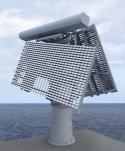
You don't have "three times" the range. SPG-51 is meant to engage up to the range of the Tartar missile, and that's only up to 30km. You're combining both C-band and X-band in a single system, and I do not see anything to suggest the transmitters are made to be much more powerful. If you are lighting the target only at terminal range, during the midphase range, your fire control radar still has to track your missile as well as the targets because it is important to know where your missile is, where it is headed, and what its speed in order to send the command instructions to it to manipulate its fins and turn the missile around to the target. That becomes a problem if your missile has a lower tail and mid section RCS, and the Standard is a much smaller missile than the Tartar. You can do this with SPY-1 because of the brute strength of the phase array, but not an oldie like the SPG-51 which is likely to be continuous wave illumination all the way from start to finish. Older Standards, pre-AEGIS work with continuous illumination all the way.
My understanding with the ASROC on the Kidd is that it uses a separate launcher, Mk 112, which has 8 ASROCs. Arm based launchers are not meant to store different sized rounds and do not have the versatility of a VLS.
Last edited:
They didn't use solid state transmitters to make the array lighter, because the transmitters are below decks. The SPS-48E uses four-stage solid state transmitters. The antenna and pedestal weigh 5600 lbs and the below deck equipment another 24000 lbs. Source: Friedman, 2006.The sheer size and weight of the SPS-48 puts limits on its rate of rotation, due to the rotating large mass creating stress on the mount. The use of solid state transmitters is an attempt to make the array lighter.
According to Friedman, one antenna is S(E) band and the other X(H) band. The single face variants in the MAE series, like the Fregat-MAE-4K operates in H band (6-8 GHz) rather than 2-3 GHz of the others. This was also confirmed by a Salyut description of the radar which mentioned that S-band and X-band antennas are used back-to-back.Top Plate does not contain an X-band side, its both on the S-band, although the smaller side might be on a different frequency than the other within the S-band range. Nothing to suggest that one side has elements that are much finer than the other which by the way, is more evident on the Type 382 (S and C-band).
SPG-51 has a declared tracking range of 200 kyards. The Kidd/Kee Lung class carry SM-2 Blk IIIA missiles, the same missiles as on the Kongo and Atago of JMSDF. From what I could find, their declared range is 90nm.You don't have "three times" the range. SPG-51 is meant to engage up to the range of the Tartar missile, and that's only up to 30km. You're combining both C-band and X-band in a single system, and I do not see anything to suggest the transmitters are made to be much more powerful. If you are lighting the target only at terminal range, during the midphase range, your fire control radar still has to track your missile as well as the targets because it is important to know where your missile is, where it is headed, and what its speed in order to send the command instructions to it to manipulate its fins and turn the missile around to the target. That becomes a problem if your missile has a lower tail and mid section RCS, and the Standard is a much smaller missile than the Tartar. You can do this with SPY-1 because of the brute strength of the phase array, but not an oldie like the SPG-51 which is likely to be continuous wave illumination all the way from start to finish. Older Standards, pre-AEGIS work with continuous illumination all the way.
Come on. Launching of ASROC was a declared capability of Mk 26. The Mk 13 on the Perrys was also a a dual purpose arm launcher: it could fire both Standard and Harpoon missiles. Finally, the rate of fire of each arm on the Mk 26 was about the same as the single arm Mk 13.My understanding with the ASROC on the Kidd is that it uses a separate launcher, Mk 112, which has 8 ASROCs. Arm based launchers are not meant to store different sized rounds and do not have the versatility of a VLS.
They didn't use solid state transmitters to make the array lighter, because the transmitters are below decks. The SPS-48E uses four-stage solid state transmitters. The antenna and pedestal weigh 5600 lbs and the below deck equipment another 24000 lbs. Source: Friedman, 2006.
According to Friedman, one antenna is S(E) band and the other X(H) band. The single face variants in the MAE series, like the Fregat-MAE-4K operates in H band (6-8 GHz) rather than 2-3 GHz of the others. This was also confirmed by a Salyut description of the radar which mentioned that S-band and X-band antennas are used back-to-back.
SPG-51 has a declared tracking range of 200 kyards. The Kidd/Kee Lung class carry SM-2 Blk IIIA missiles, the same missiles as on the Kongo and Atago of JMSDF. From what I could find, their declared range is 90nm.
Come on. Launching of ASROC was a declared capability of Mk 26. The Mk 13 on the Perrys was also a a dual purpose arm launcher: it could fire both Standard and Harpoon missiles. Finally, the rate of fire of each arm on the Mk 26 was about the same as the single arm Mk 13.
Friedman is wrong. Every reference I found says S-band. I used to have some factory brochures for the MAE too in pdf.
MAE-4K never went into service from my understanding for the lack of a customer.
Missile range for the SM-2 Block IIIA applies only for the AEGIS system and SPG-62. Your effective range is limited to how far your illumination radars can go. If it's only 50km, then your effective range is only 50km, even if your missile can travel up to 160km, but expect the rest of the journey to be unguided. If the Standards are somehow compatible to the Type 054A and is launched from that platform, and the illuminators are only good up to 75km, then your effective targeting range is only up that point. Your targeting system is not matched to the missile's potential.
For something like the Kidd, it would have to rely on handing off the missile to another asset. So let's say a Kidd fires off its Standards. It would have to hand off the missiles to an AEGIS destroyer. Unfortunately Taiwan does not have AEGIS ships, nor have they exercised with US ships on this regard. So whatever is the limits of the SPG-51, is the effective limits of the system.
The ASROC would have to be fired off from MK 112, at least with my recollection.
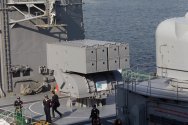
I don't know if MK 26 is dual capability.
The distance between one element to another is about 1/2 of the wavelength being used. This is why the C-band Fregat M4K looks to have a much more dense face than the two faces of the M2EM or the MAE.
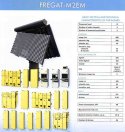
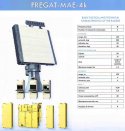
In order for one face of the Fregat to be X-band, the face would have to be much more dense than on the 4K, and that is impossible from the pictures.
The Type 382 radar is said to have dual S and C-band, and that might be true, given one face has finer and denser element and gate pattern.
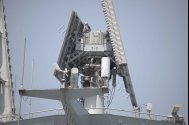


In order for one face of the Fregat to be X-band, the face would have to be much more dense than on the 4K, and that is impossible from the pictures.
The Type 382 radar is said to have dual S and C-band, and that might be true, given one face has finer and denser element and gate pattern.

I think the confusion is due to there being so many variants of the radar.Friedman is wrong. Every reference I found says S-band. I used to have some factory brochures for the MAE too in pdf.
If we follow the evolution of the radar, starting with Top Steer we can see they were all dual band radars. In Top Steer, the 2D channel (smaller antenna) operated at long and medium range; the 3D channel operated at short and medium range.
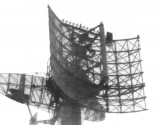
The follow on version was the Plate Steer which replaced the cylindrical reflector with a planar array:
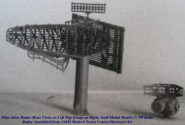
In Top Plate, the 2D antenna is replaced by a second planar array:
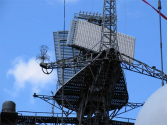
According to Friedman, there are 3 different antennas that may appear in Fregat radars. Two S(E)-band antennas: 3.4mx3.3m (shortwave band) and 3.54x2.42m (long-wave band). The X(H)-band antenna is 1.5mx1.5m.
The big and small antenna combo was installed on the Type 052B and the Sovremmenys, so S/E and X/H bands.
The 1/2 lambda rule is typically applied to electronically scannned phased arrays in order to achieve a 60 degree FOV without grating sidelobes. Some array radars sacrifice their FOV, in order to skimp on the densitiy of array elements. SBX-1 is an example of such a radar and uses a module spacing of 2.35 lambda (if it went with the 1/2 lambda spacing it would've needed 870,000 modules!). This observation make sense in the light of the fact that historically the smaller antenna was 2D. Friedman writes that in Top Plate, the smaller antenna produces a broader beam in elevation, intermediate between a fan beam of a 2D radar and the pencil beam of a true 3D radar.The distance between one element to another is about 1/2 of the wavelength being used. This is why the C-band Fregat M4K looks to have a much more dense face than the two faces of the M2EM or the MAE.
In order for one face of the Fregat to be X-band, the face would have to be much more dense than on the 4K, and that is impossible from the pictures.
The Type 382 radar is said to have dual S and C-band, and that might be true, given one face has finer and denser element and gate pattern.
View attachment 70391
Last edited:
I examined a bit more the various photos of the Top Plate radar and I think misjudged the size of the smaller antenna. From this angle the observed difference is much less:
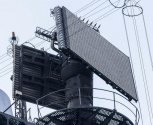
So these must be the two 2 different S-band antennas: the smaller one at the lower frequency part of S-band and the bigger one at the upper frequency part of S-band. If Friedman is right, the smaller one is not a true 3D antenna, so it's still not a simple matter of multiplying the update rate by 2.

So these must be the two 2 different S-band antennas: the smaller one at the lower frequency part of S-band and the bigger one at the upper frequency part of S-band. If Friedman is right, the smaller one is not a true 3D antenna, so it's still not a simple matter of multiplying the update rate by 2.
Last edited:
I think the confusion is due to there being so many variants of the radar.
If we follow the evolution of the radar, starting with Top Steer we can see they were all dual band radars. In Top Steer, the 2D channel (smaller antenna) operated at long and medium range; the 3D channel operated at short and medium range.
View attachment 70395
The follow on version was the Plate Steer which replaced the cylindrical reflector with a planar array:
View attachment 70396
In Top Plate, the 2D antenna is replaced by a second planar array:
View attachment 70397
According to Friedman, there are 3 different antennas that may appear in Fregat radars. Two S(E)-band antennas: 3.4mx3.3m (shortwave band) and 3.54x2.42m (long-wave band). The X(H)-band antenna is 1.5mx1.5m.
The big and small antenna combo was installed on the Type 052B and the Sovremmenys, so S/E and X/H bands.
The 1/2 lambda rule is typically applied to electronically scannned phased arrays in order to achieve a 60 degree FOV without grating sidelobes. Some array radars sacrifice their FOV, in order to skimp on the densitiy of array elements. SBX-1 is an example of such a radar and uses a module spacing of 2.35 lambda (if it went with the 1/2 lambda spacing it would've needed 870,000 modules!). This observation make sense in the light of the fact that historically the smaller antenna was 2D. Friedman writes that in Top Plate, the smaller antenna produces a broader beam in elevation, intermediate between a fan beam of a 2D radar and the pencil beam of a true 3D radar.
Top Steer is still S-band all around.
The cylindrical antenna is an early version of a frescan.
There is no small 1.5m x 1.5m array with the Fregat. Friedman is just wrong about it. I have never seen this 1.5m x 1.5m array.
Radiotutorial thinks the other array is an L-band.
I think its different bands within the S-band range.
